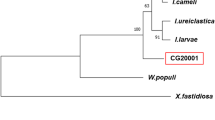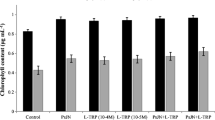Abstract
Plant-growth-suppressive activity of deleterious rhizobacteria (DRB) may be due to production of metabolites absorbed through roots. Auxins produced in high concentrations in the rhizosphere by DRB contribute to reduced root growth. Selected DRB able to produce excessive amounts of auxin compounds for suppression of weed seedling growth may be effective for biological control of weeds. The objectives to this study were to assess the ability of DRB originating from weed seedlings to synthesize auxins from L-tryptophan (L-TRP), determine effects of DRB with or without L-TRP on seedling root growth, and characterize auxins produced from L-TRP using high performance liquid chromatography (HPLC). Auxins expressed as indole-3-acetic acid (IAA)-equivalents were produced by 22.8% of the DRB tested based on a colorimetric method. Under laboratory conditions, a DRB isolate classified as Enterobacter taylorae with high auxin-producing potential (72 mg L−1 IAA-equivalents) inhibited root growth of field bindweed (Convolvulus arvensis L.) by 90.5% when combined with 10−5 M L-TRP compared with non-treated control. Auxin derivatives produced by E. taylorae from L-TRP in broth culture after 24 h incubation identified by HPLC included IAA (102 μg L−1), indole-3-aldehyde (IALD; 0.4 μg L−1), and indole-3-lactic acid (ILA; 7.6 μg L−1). Results suggest that providing L-TRP with selected auxin-producing DRB to increase phytotoxic activity against emerging weed seedlings may be a practical biological control strategy.
Similar content being viewed by others
References
Aldrich R J 1984 Weed-crop Ecology. New Breton Publ., North Scituate, Mass.
Alstrom S and Burns R G 1989 Cyanide production by rhizobacteria as a possible mechanism of plant growth inhibition. Biol. Fertil. Soils 7, 232–238.
Arshad M and Frankenberger W TJr 1991 Microbial production of plant hormones. Plant and Soil 133, 1–8.
Bakker A W and Schippers B 1987 Microbial cyanide production in the rhizosphere in relation to potato yield reductions and Pseudomonas-mediated plant growth stimulation. Soil Biol. Biochem. 19, 451–457.
Begonia M F T and Kremer R J 1994 Chemotaxis of deleterious rhizobacteria to velvetleaf (Abutilon theophrasti Medik.) seeds and seedlings. FEMS Microbiol. Ecol. 15, 227–236.
Bolton J H, Elliott L F, Gurusiddaiah S and Fredrickson J K 1989 Characterization of a toxin produced by a rhizobacterial Pseudomonas sp. that inhibits wheat growth. Plant and Soil 114, 279–287.
Broughton W J and Dilworth M J 1971 Control of leghaemoglobin synthesis in snake beans. Biochem. J 125, 1075–1080.
Brown H M and Purves W K 1976 Isolation and characterization of indole-3-acetaldehyde reductases from Cucumis sativus. J. Biol. Chem. 251, 907–913.
Chandramohan D and Mahadevan A 1968 Indole acetic acid metabolism in soils. Curr. Sci. 37, 112–113.
Curl E A and Truelove B 1986 The Rhizosphere. Springer-Verlag, New York.
Finnie J F and vanStaden J 1985 Effect of seaweed concentrate and applied hormones on in vitro cultured tomato roots. J. Plant Physiol. 120, 215–222.
Frankenberger W TJr and Brunner W 1983 Method of detection of auxin-indole-3-acetic acid in soils by high performance liquid chromatography. Soil Sci. Soc. Am. J. 41, 237–241.
Fredrickson J K and Elliott L F 1985 Effects on winter wheat seedling growth by toxin-producing rhizobacteria. Plant and Soil 83, 399–409.
Goran L, Magnus V, Simaga S, Iskric S and Hall P J 1985 Metabolism of tryptophol in higher and lower plants. Plant Physiol. 78, 447–454.
Gordon S A and Weber R P 1951 Colorimetric estimation of indole acetic acid. Plant Physiol. 26, 192–195.
Grayston S J, Stephens J H and Nelson L M 1990 Field and green-house studies on growth promotion of spring wheat inoculated with co-existant rhizobacteria: In Proc. 2nd Intl. Workshop on Plant Growth-Promoting Rhizobacteria, Oct. 14–19, 1990. Interlaken. pp 4–7.
Haahtela K, Ronkko R, Laakso T and Korhonen T K 1990 Effect of plant growth-promoting enteric bacteria in grasses. In Proc. 2nd Intl. Workshop on Plant Growth-Promoting Rhizobacteria, Oct. 14–19, 1990. Interlaken. p 125.
Holl F B, Chanway C P, Turkington R and Radley R A 1988 Response of crested wheatgrass (Agropyron cristatum L.), perennial ryegrass (Lolium perenne L.) and white clover (Trifolium repens L.) to inoculation with Bacillus polymyxa. Soil Biol. Biochem. 20, 19–24.
Kampert M, Strzelczyk E and Pokojska A 1975 Production of auxins by bacteria isolated from the roots of pine seedlings (Pinus sylvestris L.). Acta. Microbiol. Pollut. 7, 135–143.
Kaper J M and Veldstra H 1958 On the metabolism of L-tryptophan by Arobacterium tumefaciens. Biochim. Biophys. Acta 30, 401–420.
Kennedy A C, Elliott L F, Young F L and Ogg A GJr 1991 Rhizobacteria suppressive to the weed downy brome. Soil Sci. Soc. Am. J. 55, 722–727.
Kremer R J, Begonia M F T, Stanley L and Lanham E T 1990 Characterization of rhizobacteria associated with weed seedlings. Appl. Environ. Microbiol. 56, 1649–1655.
Loper J E and Schroth M N 1986 Influence of bacteria sources of indole-3-acetic acid on root elongation of sugarbeet. Phytopathology 76, 386–389.
Muller M, Deigele C and Ziegler H 1989 Hormonal interactions in the rhizosphere of maize (Zea mays L.) and their effects on plant development. Z. Pflanzenernahr. Bodenkd, 152, 247–254.
Sarwar M, Arshad M, Martens D A and Frankenberger W TJr 1992 Tryptophan-dependent biosynthesis of auxins in soil. Plant and Soil 147, 207–215.
Sarwar M and Frankenberger W TJr 1994 Influence of L-tryptophan and auxins applied to the rhizosphere on the vegetative growth of Zea mays L. Plant and Soil 160, 97–104.
Sasser M 1990 Identification of bacteria through fatty acid analysis. In Methods in Phytobacteriology. Eds. Z Klement, K Rudolph and D C Sands. pp 199–204. Akadamiai Kiado, Budapest.
Schippers B, Bakker A W and Bakker P A H M 1987 Interactions of deleterious and beneficial rhizosphere microorganisms and the effect of cropping practices. Annu. Rev. Phytopathol. 25, 339–358.
Schroth M N and Hancock J G 1982 Disease-suppressive soil and root-colonizing bacteria. Science 216, 1376–1381.
Scott T K 1972 Auxins and roots. Annu. Rev. Plant Physiol. 23, 235–258.
Selvadurai E L, Brown A E and Hamilton J T G 1991 Production of indole-3-acetic acid analogues by strains of Bacillus cereus in relation to their influence on seedling development. Soil Biol. Biochem. 23, 401–403.
Smidt M and Kosuge T 1978 The role of indole-3-acetic acid accumulation by alpha methyl tryptophan-resistant mutants of Pseudomonas savastanoi in gall formation on oleanders. Physiol. Plant Pathol. 13, 203–214.
Stein A, Fortin J A and Vallee G 1990 Enhanced rooting of Picea mariana cuttings by ectomycorrhizal fungi. Can. J. Bot. 68, 492–498.
Strzelczyk E and Pokojska-Burdzeij A 1984 Production of auxins and gibberellin-like substances by mycorrbizal fungi, bacteria and actinomycetes isolated from soil and the mycorrhizosphere of pine (Pinus silvestris L.). Plant and Soil 81, 185–194.
Suslow T V and Schroth M N 1982 Role of deleterious rhizobacteria as minor pathogens in reducing plant growth. Phytopathology 72, 111–115.
Templeton G E and Smith R JJr 1977 Managing weeds with pathogens. In Plant Disease: An Advanced Treatise. Eds. J G Horsfall and E B Cowling. pp 167–176. Academic Press Inc., New York.
Weller D M 1988 Biological control of soilborne plant pathogens in the rhizosphere with bacteria. Annu. Rev. Phytopathol. 26, 379–407.
Zimmer W, Roeben K and Bothe H 1988 An alternative explanation for plant growth promotion by bacteria of the genus Azospirillum. Planta 176, 333–342.
Author information
Authors and Affiliations
Rights and permissions
About this article
Cite this article
Sarwar, M., Kremer, R.J. Enhanced suppression of plant growth through production of L-tryptophan-derived compounds by deleterious rhizobacteria. Plant Soil 172, 261–269 (1995). https://doi.org/10.1007/BF00011328
Received:
Accepted:
Issue Date:
DOI: https://doi.org/10.1007/BF00011328




